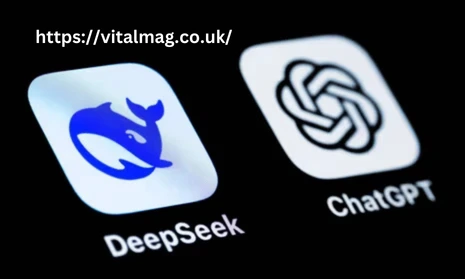Introduction
In recent years, the world of artificial intelligence (AI) has witnessed extraordinary advancements, with cutting-edge models primarily focused on language processing, data analysis, and decision-making. When ChatGPT dominated the AI landscape, a critical question arose: would it become a challenge for China’s technological ambitions? However, in just two years, a new Chinese AI model DeepSeek has flipped the question: Can the U.S. stop Chinese innovations?
Initially, Beijing appeared to falter in the face of ChatGPT since the app wasn’t even available in China. Users ridiculed Baidu’s chatbot, Ernie, and later dismissed versions from tech giants Tencent and ByteDance as subpar. Confident in its lead, Washington sought to maintain its dominance by imposing strict export restrictions on chips and technology to China. This made the breakthrough of DeepSeek, a little-known company, all the more astonishing. According to DeepSeek, its AI model is significantly cheaper than those developed by U.S. firms that have invested billions in AI.
The question arises: How did an obscure company—whose founder is hailed as an “AI hero” on Chinese social media—achieve such a feat?
DeepSeek’s Disruptive Impact on the Global AI Market
Chinese company has shaken the foundations of the global AI industry. Its success is not just a reflection of technical superiority but also a challenge to the economic and practical limitations of AI development.
Founded in 2023 in Hangzhou, DeepSeek developed an AI model with limited resources that competes with, and in some areas surpasses, existing models. The company’s primary objective is to create Artificial General Intelligence (AGI) capable of enhancing various aspects of human life. DeepSeek’s innovative techniques and cutting-edge models have drawn global attention.
DeepSeek-R1: A Technological Marvel
DeepSeek’s model, DeepSeek-R1, represents a major technological breakthrough. It comprises 671 billion parameters but employs a novel technique known as Mixture of Experts (MoE), which activates only 37 billion parameters per input. This approach reduces energy consumption while improving processing efficiency. The training cost was only $5.6 million, a stark contrast to OpenAI’s GPT-4, which required over $100 million.
Additionally, DeepSeek leveraged Reinforcement Learning to train the model without relying on vast datasets, significantly enhancing its reasoning and problem-solving abilities.
Overcoming U.S. Chip Sanctions
The U.S. government’s restrictions on selling advanced chips to China dealt a major blow to Beijing’s AI ambitions. These chips are critical for training powerful AI models capable of answering basic queries and solving complex mathematical problems.
In interviews, DeepSeek founder Liang Wenfeng acknowledged that chip shortages were a significant hurdle. Before the sanctions, DeepSeek required a large supply of Nvidia’s A100 chips—estimated to be between 10,000 and 50,000. In comparison, Western AI models typically use around 16,000 specialized chips. However, DeepSeek claims to have trained its model using just 2,000 chips, supplemented with thousands of lower-grade processors, significantly reducing costs.
Industry giants like Elon Musk have questioned these claims, arguing that DeepSeek cannot operate at this scale without access to advanced chips. Nevertheless, experts believe that Washington’s restrictions have presented both challenges and opportunities for China’s AI industry. According to Marina Zhang, an associate professor at Sydney’s University of Technology, these sanctions have pushed companies like DeepSeek to develop cost-effective alternatives, fostering innovation aligned with China’s broader goal of technological independence.
China’s AI Boom and Government Support
From electric vehicle batteries and solar panels to artificial intelligence, China has made substantial investments in technology. Becoming a tech superpower has been a long-standing ambition of President Xi Jinping, and U.S. sanctions were a direct challenge that Beijing had to overcome.
According to Gregory C. Allen of the Center for Strategic and International Studies, China deliberately launched DeepSeek’s latest model on January 20, the day of U.S. President Donald Trump’s inauguration, as a symbolic message. Allen, a former policy director at the Pentagon’s Joint Artificial Intelligence Center, noted that the timing and manner of the announcement aligned perfectly with the Chinese government’s strategic communications.
In recent years, China has cultivated AI talent by offering scholarships, research grants, and encouraging university-industry partnerships. The National Engineering Laboratory and other state-backed initiatives have trained thousands of AI specialists, ensuring a steady supply of skilled professionals.
The DeepSeek Team: A New Generation of AI Entrepreneurs
According to Chinese media, DeepSeek’s 140-member team consists predominantly of homegrown talent from top Chinese universities. Marina Zhang suggests that Western analysts have underestimated a new wave of Chinese entrepreneurs who prioritize fundamental research and long-term technological advancement over short-term profits. This new generation, raised during China’s rapid technological rise, is highly driven by innovation and self-reliance.
DeepSeek founder Liang Wenfeng, 40, exemplifies this trend. A graduate of Zhejiang University with degrees in electronic information and communication engineering, he initially experimented with AI applications in a small Chengdu apartment before finding success in AI-driven financial trading. In 2016, he co-founded High Flyer, a company that integrates AI with quantitative trading. In 2023, he launched DeepSeek, aiming to create a Chinese equivalent of ChatGPT.
The Global Rise of DeepSeek
Within ten days of its launch, DeepSeek became the most downloaded app in over 50 countries, including the U.S. Liang Wenfeng has emerged as a national AI icon, celebrated alongside Zhilin Yang and Kaiming He—renowned Chinese AI experts.
The launch, just before the Lunar New Year, sparked excitement across Chinese social media. A user on Weibo described it as “the best New Year’s gift,” hailing DeepSeek as a testament to China’s growing technological prowess.
Facing Challenges: Cyberattacks and U.S. Market Restrictions
DeepSeek’s rapid rise has sent shockwaves through the U.S. and European AI investment landscape. The company’s emergence coincided with a $500 billion decline in Nvidia’s market value, reflecting investor anxiety over China’s AI advancements. Even U.S. President Donald Trump acknowledged the development, warning American tech firms to take the Chinese challenge seriously.
In response to cyberattacks, DeepSeek temporarily restricted new user registrations. Meanwhile, questions linger over how it managed to develop such a sophisticated model at a fraction of the cost of its Western competitors.
The Future of AI: A U.S.-China Rivalry
DeepSeek’s success has sparked debates about the future of AI dominance. Just days before its launch, OpenAI and other leading firms announced a historic $500 billion investment in the U.S. AI sector. Trump reassured the industry that America would remain the epicenter of technological advancement.
However, DeepSeek’s breakthrough demonstrates that China is no longer a passive observer in the AI race. With continued government support and a new generation of AI innovators, the battle for AI supremacy is far from over.
Conclusion: A New Era in AI Competition
DeepSeek’s meteoric rise marks a turning point in the global AI landscape. Despite U.S. sanctions and limited access to cutting-edge chips, the company has demonstrated that innovation can thrive under constraints. By leveraging cost-effective solutions, government support, and a new generation of AI talent, China has positioned itself as a formidable contender in the AI arms race.
While the U.S. still maintains a stronghold on AI research and infrastructure, DeepSeek’s breakthrough signals a shift in the balance of power. The competition between China and the U.S. is no longer just about who develops the best models but about who can sustain AI progress amid geopolitical tensions. As both nations ramp up investments and regulatory measures, the world stands on the precipice of a new era—one where AI leadership is no longer monopolized but fiercely contested.
The battle for AI dominance is far from over, and DeepSeek is just the beginning.








